This post is part of a larger deep dive
Curious about the role of the USA in WWII and "A Clean, Well-Lighted Place" by Ernest Hemingway in Nighthawks? Check out Nighthawks Explained!
Or read the full Nighthawks article!
This post is part of a larger deep dive
Curious about the role of the USA in WWII and "A Clean, Well-Lighted Place" by Ernest Hemingway in Nighthawks? Check out Nighthawks Explained!
Or read the full Nighthawks article!
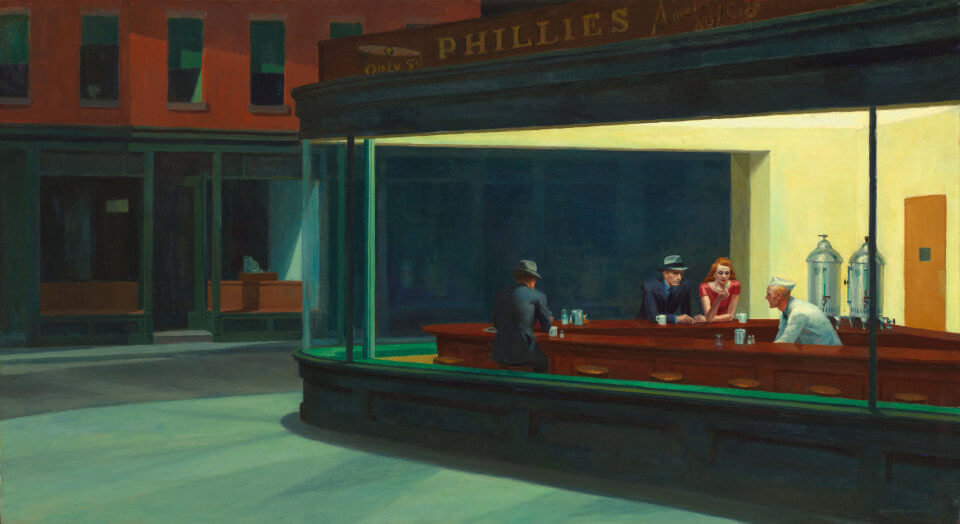
For the analysis of Nighthawks, I decided to go over the most salient elements in the painting: the man seating alone, the couple, the barman, the lighting/colours, the diner, and the empty street.
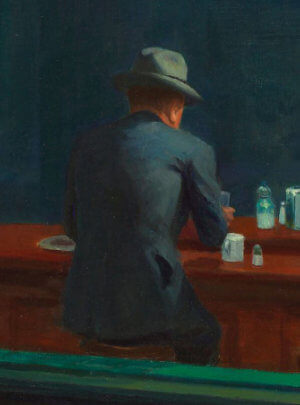
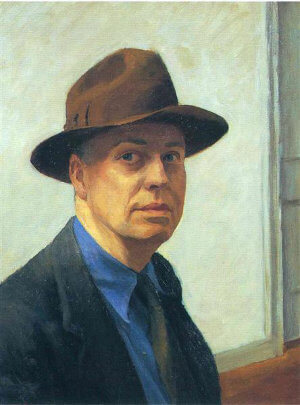
A close inspection of this figure, one cannot but wonder if this isn’t Hopper himself. Indeed, many of his self-portraits bear striking resemblance with this character (see the self-portrait shown above).
This man holds a newspaper under the arm, which some speculate could be a journal bringing news of the war, even though Hopper didn’t take particularly interest in the ongoing war.
The man appears absorbed in his own thoughts, looking at his glass. There is no attempt (or wish?) to interact with either the waiter or with the couple.
Hopper’s prowess to imbue his paintings with sadness and loneliness couldn’t be more successful with this element really. We cannot see the man’s face, but the curved posture, the slightly tilted head and the lack of companionship surely transpires loneliness.
When I read Hemmingway’s short story “A Clean, Well-Lighted Place” I immediately associated the old man in the story with the lonely man in Hopper’s painting.
In this short story, an old deaf man is also seating alone in a clean and well-lit café at night, drinking. Apparently, the old man is well off, but he attempted suicide out of despair and loneliness (one of the waiters mention that he once had a wife, so perhaps he lives all by himself and does not have children).
Another character in the story, the older waiter, sympathises with the old man’s troubles. He philosophises that life is nothingness, and this realization causes one to despair, particularly as we age and begin to lack confidence.
Hopper was a great admirer of Hemingway, so I do not doubt this short story (which was published 9 years before Nighthawks) somehow found its way into Hopper’s hands.
Hopper was himself an extremely introvert person and had bouts of depression, so it’s not a stretch to imagine that he could have identified himself with the old men’s plight.
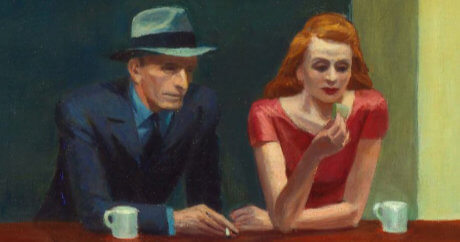
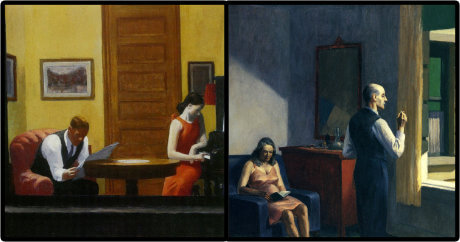
The man and woman seating next to each other has been a topic of much debate.
If you have seen other of Hopper’s work, you have probably noticed that the couples he often paints are almost never communicating. In fact, they often appear sad, as if entrapped and resigned inside an unhappy relationship.
This is certainly true of Nighthawks. Both the man and the woman aren’t talking to each other. The man is smoking a cigarette while the woman is eating a sandwich, and they are both absorbed in their own thoughts.
About the ubiquitous lack of communication between couples in Hopper’s many paintings, Hopper noted “It’s probably a reflection of my own, if I may say, loneliness. I don’t know. It could be the whole human condition.”
As mentioned earlier, Hopper’s wife, Josephine, seemingly posed for the woman in the red dress. Even though Hopper and Josephine married and remained married until their deaths, their marriage couldn’t be described as a happy one. The couple had often arguments that resulted in silence for days, or worse, developed into actual fights. Hopper failed to support her career, ridiculed her work, and was physically abusive.
It is, therefore, noteworthy that the man seating alone, who might be Hopper himself, is seating at a distance from his wife.
Was Hopper giving us a hint (either consciously or not) about how he saw his relationship with his wife? Close in physical space (in the same diner), but distant emotionally (seated far away from each other)?
Regardless of the answer to that question, it is clear that the couple doesn’t seem very happy either. Some art experts have suggested that they might be strangers, but I find that hard to believe. It’s true that the hands aren’t touching, but they are “almost” touching, which kind of suggests they may at least know each other. Also, for a fairly empty diner, there would be no reason to sit so close to each other, especially since the entrance appears to be situated on the opposite side of the diner.
Note that the man with the beaked nose was apparently also modelled around Hopper (according to Josephine’s annotations, the shape of the man’s nose led Josephine to name the painting “Nighthawks”), although I do not find the physiognomy to be very close to Hopper’s facial features (although the same could be said of the woman and Josephine). Due to the almost inexistence of male or female models, Hopper probably resorted to painting men based on his figure, but it’s likely the beaked-nose man is intended to be a stranger.
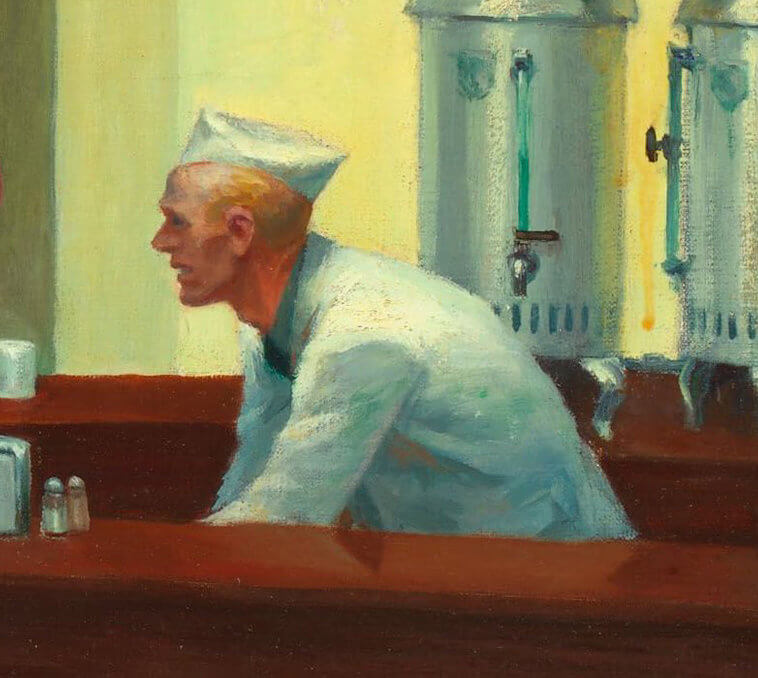
Not many analyses of this painting have much to say about the waiter. He is busy doing something under the counter – perhaps cleaning, perhaps preparing another drink.
At first glance, it looks like he is conversing with the beaked-nose man, but it isn’t clear if he is looking directly at him. Closer inspection reveals a facial expression of a certain apprehension as well.
So, and contrary to Hemingway’s short story, not even the young waiter seems to escape this sense of alienation that is pervasive in all the diner’s occupants.
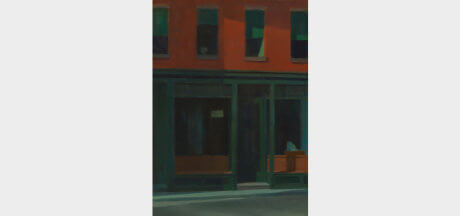
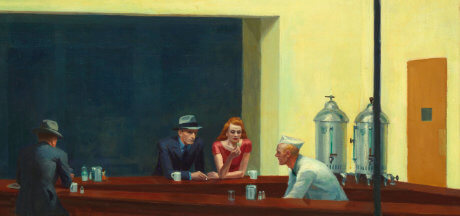
The lighting inside the diner was inspired by the novel neon lights, introduced in the US in the 1940s.
Hopper was obsessed with light and studied it with great care. He was particularly attentive at how light reflected off people and buildings. The deeply observant Hopper once said: “As a child I felt that the light on the upper part of a home was different from that on the lower part. There is a sort of elation about sunlight on the upper part of a house.”
Hopper’s close study of light and colour and its application on Nighthawks is one crucial aspect of the painting that gives this piece it’s eerie vibe.
Yellow is a colour that quickly grabs your attention, and I think this is exactly what Hopper intended – that our gaze shifts immediately to the interior of the diner.
In addition, being a very bright and warm colour, it stands in stark contrast to the more washed out tones outside the diner, further accentuating the duality between alive and nothingness. In fact, the only vestige of brightness in the outside street comes from the lights emanating from the inside of diner.

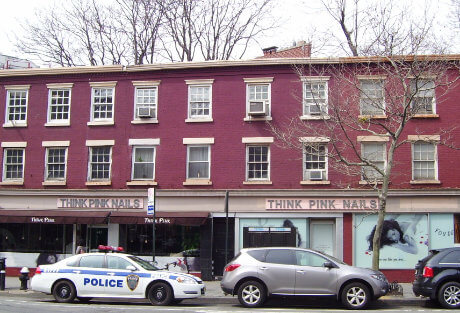
Because Hopper spent most of his life in Greenwich village, New York, many have speculated that the diner was situated somewhere there. Indeed, the brick buildings on the street do resemble of buildings that dot the village here and there (see figure above). However, most art experts have concluded that Hopper didn’t base the diner on any actual physical diner.
It’s more likely that the diner is simply a composite of some kind, as Hopper once famously said that most of his paintings are not taken from any particular scene, but are rather composites.
The diner is superbly cleaned, which, again, brings to mind Hemingway’s short story “A Clean, Well-Lighted Place”.
In the story, the older waiter makes a comment that the old man drinks without spilling, even drunk, so he doesn’t really make a mess in the café. The waiter goes on talking about the importance of having a clean, well-lit, and pleasant café, for people to come into in times of need. Such a café is, according to the waiter, a space where lonely individuals can deal with their despair and drink themselves unconscious, enabling a temporary reprieve from all the emptiness they harbour.
This is undoubtedly the feeling Hopper’s diner transpires. It is clean, well-lit, and pleasant. The old man seating alone is even drinking something (I’d be tempted to say brandy, as that was what the old deaf man was drinking in Hemingway’s short story, but the glass the man is holding in the painting doesn’t appear to be a snifter).
Based on the empty coffee tureens, it’s safe to assume it is very late at night. Maybe, as with the older waiter, the three patrons suffer from insomnia and came to the diner for a bit of light to shine over their melancholy. What best place to drown one’s sorrows than a well-lighted and clean diner?
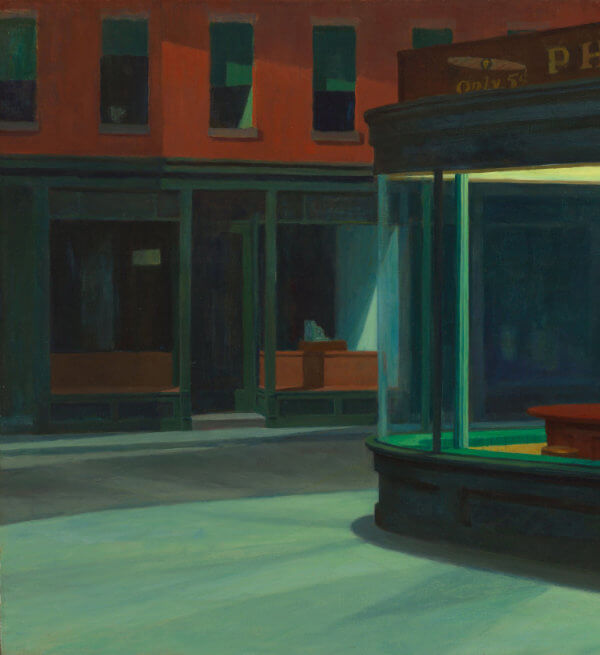
Contrary to the inside of the diner, the outside street is devoid of life. There are no passers-by and the only visible shop window is completely empty except a cash register, as if the shop were out of business. The flats above the empty shop are all dark – no lights – probably suggesting that they too are uninhabited.
Note how Hopper deliberately chose not to include a single element outside the diner that may be suggestive of some continuance of life. For example, he could have placed a parked motorbike, a single lit lamp in one of the flats, a person looking out of a window, a bird, a stray dog passing by, hell, even dog poo on the pavement.
But, there is nothing.
With it, Hopper wants to accentuate this divide between emptiness (nothingness) and life.
Coming back to Hemingway’s short story, the inner worlds of both older men are permeated by emptiness.
So, perhaps the outside darker street is a representation of this nothingness that most of us are likely to feel at some point, whereas the well-lighted diner is the refuge that makes that nothingness more bearable.
Nighthawks brilliantly depicts human loneliness in a place (New York) that, paradoxically, is the most populated city in the US.
Note, however, that Hopper never explicitly gave meaning to this painting, although he acknowledged that unconsciously he might have painted the loneliness of a large city.
The painting was completed in the midst of the second world war, at a time when the mood in New York city was one of anxiety and mistrust. The focus on the war effort and the sacrifices it required (rationing, cut on spending, blackout drills, etc.) meant a decrease in socializing, and, consequently, more desolate and lonely places. Nighthawks captures this solitude magnificently.
But Nighthawks shows another side – a brighter (though not necessarily happy) side. Perhaps influenced by Hemingway’s short story “A Clean, Well-Lighted Place”, the well-lit and clean diner could be viewed as a refuge for warding off loneliness; a place which is always present, always available for those of us, tormented souls, unable to sleep at night.
Hopper’s combination of lighting and colours brings to the fore the stark contrast between the alive (interior of the diner) and nothingness (outside the diner).
Although no customer appears happy inside the diner, the prospect of coming out (into nothingness) is, I guess, more foreboding.
Perhaps that is the reason why the diner in Nighthawks has no door. To me, that represents a glimpse of hope that we might not be entirely alone in the combat against nothingness. After all, there is always a clean, well-lit diner around the corner.
The older men in “A Clean, Well-Lighted Place” would have surely welcomed it.
Whether Nighthawks should be interpreted as a work depicting human isolation is open for debate.
It is true that Hopper alluded to the idea that Nighthawks portrayed the loneliness of a large, urban city but, as I mentioned above, he never really gave any explicit meaning to this painting.
I try to shy away from overinterpreting artworks, but in the case of Nighthawks, Hopper clearly wished the viewer to come up with his/her own narrative.
And how clever it was of Hopper to choose a mundane scene such as this, which we can all surely relate to. After all, haven’t we all, at some point, felt comfort in seating alone at a cozy café and contemplate life?
I sure have.
See you in the next article!
Leave a comment
Add Your Recommendations
Popular Tags